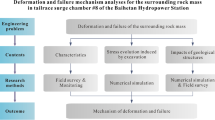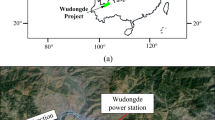Abstract
The underground powerhouse of the Houziyan Hydropower Station is under the conditions of high geo-stress and a low strength/stress ratio, which leads to significant rock deformation and failures, especially for rock pillars due to bidirectional unloading during the excavation process. Damages occurred in thinner rock pillars after excavation due to unloading and stress concentration, which will reduce the surrounding rock integrity and threaten the safety of the underground powerhouse. By using field investigations and multi-source monitoring data, the deformation and failure characteristics of a rock pillar are analyzed from the tempo-spatial distribution features. These results indicate that significant deformation occurred in the rock pillar when the powerhouse was excavated to the fourth layer, and the maximum displacement reached 107.57 mm, which occurred on the main transformer chamber upstream sidewall at an elevation of 1721.20 m. The rock deformation surrounding the rock pillar is closely related to the excavation process and has significant time-related characteristics. To control large deformation of the rock pillar, thru-anchor cables were used to reinforce the rock pillar to ensure the stability of the powerhouse. The rock deformation surrounding the rock pillar decreases gradually and forms a convergent trend after reinforcement measures are installed based on the analysis of the temporal characteristics and the rock pillar deformation rate.














Similar content being viewed by others
References
Barbero M, Barla G (2010) Stability analysis of a rock column in seismic conditions. Rock Mech Rock Eng 43:845–855
Barla G, Monacis G, Perino A, Hatzor YH (2010) Distinct element modelling in static and dynamic conditions with application to an underground archaeological site. Rock Mech Rock Eng 43:877–890
Barton N (2007) Rock quality, seismic velocity, attenuation and anisotropy. Taylor & Francis, London
Cai M (2008) Influence of second principal stress on rock fracturing and strength near excavation boundaries-insight from numerical modeling. Int J Rock Mech Min Sci 45:763–772
Cai M, Kaiser PK, Martin CD (2001) Quantification of rock mass damage in underground excavations from microseismic event monitoring. Int J Rock Mech Min Sci 38:1135–1145
Dai F, Li B, Xu NW, Fan YL, Zhang CQ (2016) Deformation forecasting and stability analysis of large-scale underground powerhouse caverns from microseismic monitoring. Int J Rock Mech Min Sci 86:269–281
Dai F, Li B, Xu NW, Zhu YG (2017) Microseismic early warning of surrounding rock mass deformation in the underground powerhouse of the Houziyan hydropower station, China. Tunn Undergr Space Technol 62:64–74
Deng JH, Lee CF, Ge XR (2001) Characterization of the disturbed zone in a large rock excavation for the three gorges project. Can Geotech J 38:95–106
Dong JY, Yang JH, Yang GX (2011) Analysis on causes of deformation and failure of large scale underground powerhouse. Appl Mech Mater 71–78:644–650
Fattahi H, Shojaee S, Farsangi MAE, Mansouri H (2013) Hybrid Monte Carlo simulation and ANFIS-subtractive clustering method for reliability analysis of the excavation damaged zone in underground spaces. Comput Geotech 54:210–221
Huang QX, Deng JH, Su PY, Wang DK, You P (2011a) Displacement characteristics analysis of surrounding rock in underground powerhouse chambers at Pubugou hydropower station during construction. Chin J Rock Mech Eng 30:3032–3042 (in Chinese)
Huang RQ, Huang D, Duan SH, Wu Q (2011b) Geomechanics mechanism and characteristics of surrounding rock mass deformation failure in construction phase for underground powerhouse of Jinping I hydropower station. Chin J Rock Mech Eng 30:23–35 (in Chinese)
Jiang Q, Feng XT, Cui J, Li SJ (2015) Failure mechanism of unbonded prestressed thru-anchor cables: in situ investigation in large underground caverns. Rock Mech Rock Eng 48(2):873–878
Khaledi K, Mahmoudi E, Datcheva M, Schanz T (2016) Stability and serviceability of underground energy storage caverns in rock salt subjected to mechanical cyclic loading. Int J Rock Mech Min Sci 86:115–131
Kim HM, Rutqvist J, Jwong JH, Choi BH, Ryu DW, Song WK (2013) Characterizing excavation damaged zone and stability of pressurized lined rock caverns for underground compressed air energy storage. Rock Mech Rock Eng 46:1113–1124
Kim HM, Rutqvist J, Kim H, Park D, Ryu DW, Park ES (2016) Failure monitoring and leakage detection for underground storage of compressed air energy in lined rock caverns. Rock Mech Rock Eng 49:573–584
Li HB, Liu MC, Xing WB, Shao S, Zhou JW (2017) Failure mechanisms and evolution assessment of the excavation damaged zones in a large-scale and deeply buried underground powerhouse. Rock Mech Rock Eng. doi:10.1007/s00603-017-1208-0
Martino JB, Chandler NA (2004) Excavation-induced damage studies at the underground research laboratory. Int J Rock Mech Min Sci 41:1413–1426
Park D, Ryu DW, Choi BH (2014) Numerical analysis-based shape design of underground rock caverns for thermal energy storage. Rock Mech Rock Eng 47:2307–2312
Peng Q, Wang DK, Deng JH, Xie HP, Tang R, Gao P (2007) Analysis of surrounding rock deformation characteristics in underground powerhouse. Chin J Rock Mech Eng 26:2583–2587 (in Chinese)
Wu F, Hu X, Gong M, Liu J, Ren A (2010a) Unloading deformation during layered excavation for the underground powerhouse of Jinping I hydropower station, southwest China. Bull Eng Geol Environ 69(3):343–351
Wu SY, Shen MB, Wang J (2010b) Jinping hydropower project: main technical issues on engineering geology and rock mechanics. Bull Eng Geol Environ 69(3):325–332
Xu NW, Dai F, Li B, Zhu YG, Zhao T, Yang DS (2017) Comprehensive evaluation of excavation-damaged zones in the deep underground caverns of the Houziyan hydropower station, Southwest China. Bull Eng Geol Environ 76:275–293
Yoshida H, Horii H (2004) Micromechanics-based continuum model for a jointed rock mass and excavation analyses of a large-scale cavern. Int J Rock Mech Min Sci 41(1):119–145
Zhou JW, Yang XG, Li HT, Zhou HW, Hu W (2012) Analysis of excavation damaged zone of auxiliary tunnel based on field wave velocity test at the Jinping hydropower station. In: Proceeding of the 2nd ISRM international young scholars’ symposium on rock mechanics, October 2012, Beijing, pp 65–71
Zhou JW, Yang XG, Hu W, Duan RJ, Hu XW (2013) Deformation and failure characteristics of a large underground caverns influenced by the faults. In: Proceeding of the international symposium and 9th Asian regional conference of IAEG, September 2013, Beijing, pp 337–343
Zhu WS, Li XJ, Zhang QB, Zheng WH, Xin XL, Sun AH, Li SC (2010) A study on sidewall displacement prediction and stability evaluations for large underground power station caverns. Int J Rock Mech Min Sci 47(7):1055–1062
Zhu W, Yang W, Li X, Xiang L, Yu D (2014) Study on splitting failure in rock masses by simulation test, site monitoring and energy model. Tunn Undergr Space Technol 41:152–164
Acknowledgements
The authors are grateful for the financial support from the National Natural Science Foundation of China (51679158) and the Science Foundation for Excellent Youth Scholars of Sichuan University (2013SCU04A07). Critical comments by the anonymous reviewers greatly improved the initial manuscript.
Author information
Authors and Affiliations
Corresponding author
Rights and permissions
About this article
Cite this article
Xiao, Xh., Xiao, Pw., Dai, F. et al. Large Deformation Characteristics and Reinforcement Measures for a Rock Pillar in the Houziyan Underground Powerhouse. Rock Mech Rock Eng 51, 561–578 (2018). https://doi.org/10.1007/s00603-017-1329-5
Received:
Accepted:
Published:
Issue Date:
DOI: https://doi.org/10.1007/s00603-017-1329-5




